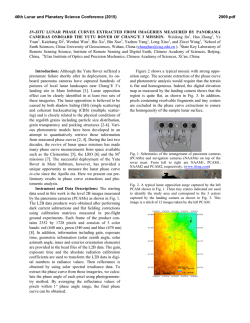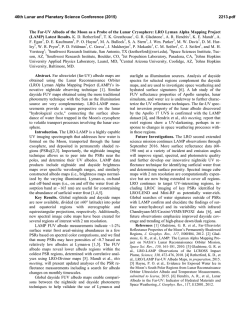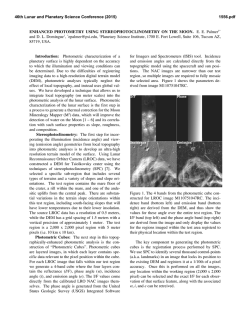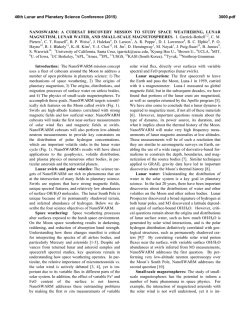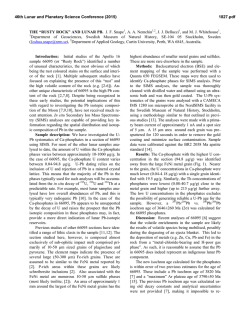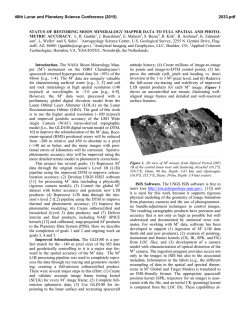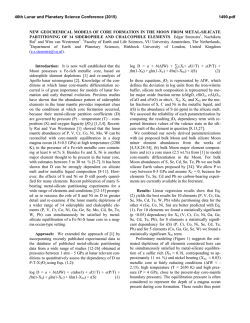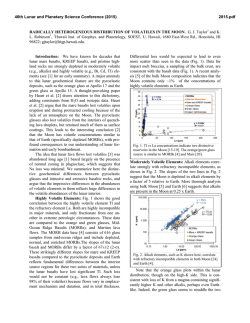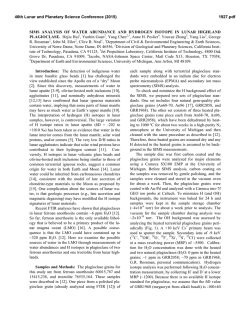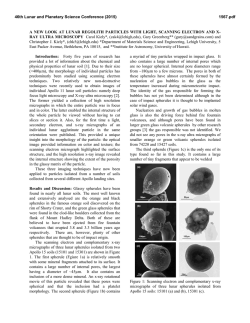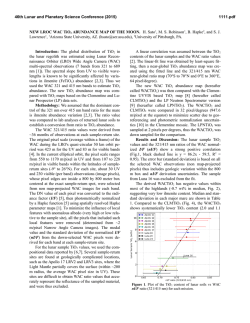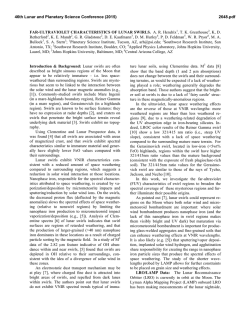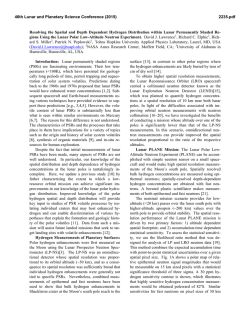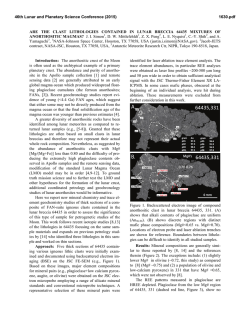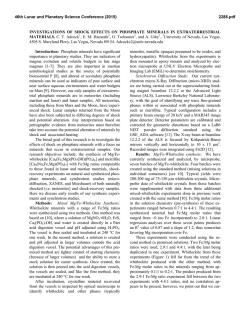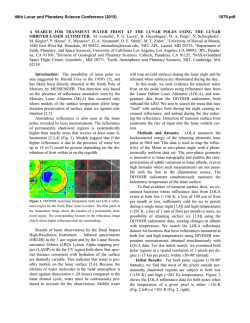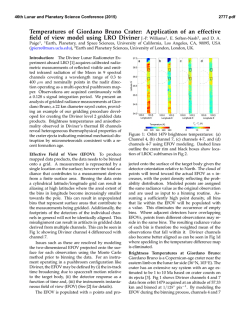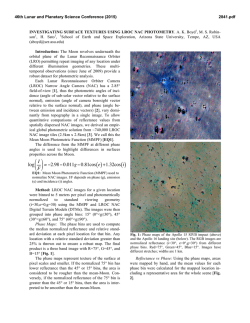
Disk Integrated Hapke Photometric Parameters of the Lunar Surface
46th Lunar and Planetary Science Conference (2015) 2321.pdf DISK INTEGRATED HAPKE PHOTOMETRIC PARAMETERS OF THE LUNAR SURFACE IN THE ULTRAVIOLET. M. M. Osterloo1, G. M. Holsclaw1, and M. Snow1, 1University of Colorado, Laboratory for Atmospheric and Space Physics, 3665 Discovery Dr., Boulder, CO 80303 ([email protected]) Introduction: Although lunar soil samples were returned to Earth and have been studied extensively in the laboratory, there is still much to learn from remote sensing observations of the Moon’s regolith. Measurements of the reflected sunlight from the outermost layer of the Moon can be used to determine particle size and porosity, surface roughness and scattering properties, and space weathering effects from long term exposure to solar wind, solar irradiance, galactic cosmic rays, and micrometeroid bombardment. There have been relatively few studies of the lunar ultraviolet (UV) spectral irradiance, and none that have covered the full range of possible phase angles. Therefore prior measurements have poorly constrained the surface properties at these wavelengths. In the visible and near-infrared wavelength regions, a weathered surface will appear darker, relatively more red, and with reduced contrast in diagnostic absorption features in comparison with a fresh surface. But in the ultraviolet, these effects are reversed (1, 2) Dataset: The data used in this study come from the SOLar Stellar Irradiance Comparison Experiment II (SOLSTICE II) onboard the SOLar Radiation and Climate Experiment (SORCE) (3). The instrument design is described in detail in (4). SOLSTICE is a grating spectrometer that measures irradiance in the wavelength range of 115 to 300 nm. Its primary mission is to measure the absolute solar irradiance on a daily basis in order to understand the solar variability side of the Sun-Earth connection. To track instrumental changes over time it measures the ratio of solar irradiance to the irradiance of an ensemble of bright, early-type stars (5). We have used some of the orbit eclipse observing time, which is normally devoted to stellar calibration observations, to measure the spectral irradiance from the Moon. We have over two years of observations for detailed analysis. For a full description of the dataset, uncertainties and error analysis see (6,7). Importantly and unique to this dataset, the albedo measurement from SOLSTICE is highly accurate since the same instrument makes both the solar and lunar irradiance measurement. Therefore, the calibration uncertainty cancels out in the ratio of irradiances. Photometric Model: From the measured SOLSTICE ultraviolet phase curves for each wavelength, we fit Hapke’s photometric model to better understand the lunar surface reflectance properties at these wavelengths (8). The photometric characteristics modeled include single-scattering albedo, forward and backscattering, opposition amplitude, opposition width, and the average tilt of the surface characterizing macroscopic roughness. The result of this modeling is a set of six photometric parameters at each wavelength across the 115- 300 nm range, which is presented here. Preliminary Results: Figure 1 shows our initial Hapke modeling results for W, the single scattering albedo parameter versus wavelength. Within the mid ultraviolet (MUV) the albedo decreases with shorter wavelengths, consistent with previous observations (e.g., 9). However, in the far ultraviolet (FUV) the single scattering albedo begins to increase with decreasing wavelength. These preliminary results are derived by allowing all parameters to vary and they have been spot checked at various wavelengths for accuracy by allowing only a single parameter to vary. Continued analysis wherein only certain parameters are allowed to vary or allowing combinations of parameters to vary may refine our results. Figure 1. W, the single scattering albedo, vs. wavelength. Red boxes are the results of our MUV spectra and blue diamonds are the results of our FUV spectra. Key Implications: Opposition surge. There are two fundamentally different physical mechanisms that contribute to the opposition surge. The first is known as the shadow hiding opposition effect. At non-zero phase angles, the observer sees a combination of reflecting particle sand their shadows. As the phase angle decreases to zero, the fraction of the visible surface that is shadowed by other parts of the surface also goes to zero. The second mechanism is the coherent backscatter opposition ef- 46th Lunar and Planetary Science Conference (2015) fect is the result of two correlated wave fronts which transit the same multiply-scattered path but in opposite directions that re-emerge and interfere constructively. Several studies have arrived at conflicting results as to which mechanism dominates (8,10). Measurements of the opposition effect over the wavelength range spanned by SOLSTICE can contribute to this discussion. Since coherent backscatter relies on multiple scattering, its significance should be proportional to reflectance. Therefore, over the wavelength range of SOLSTICE, we should see a transition from some combination of the two effects at long wavelengths to a region where shadow hiding dominates at short wavelengths. By isolating one of these mechanisms, we anticipate to be able to better understand how these two effects contribute to the opposition surface at all wavelengths. Previous results (11) found a value of 0.05 for the opposition angular width parameter, h. Our initial MUV observations indicate a larger value of h, although further analysis may refine this value. Surface Roughness. The SOLSTICE dataset provides broad phase coverage of the Moon that is unparalleled and enables a study of the global macroscopic surface roughness. The two previous comprehensive efforts to characterize the disk-integrated photometric behavior of the Moon in the visible and near infrared wavelength region by (12,13) were limited to a maximum phase angle of 120° and 90°, respectively. SOLSTICE measures the phase curve of the Moon out to 170°, both before and after full Moon. The Hapke photometric model includes a single term, θ (surface tilt), to describe the variation in light received from sub-resolution spatial scales due to topographical relief. Because the effect of surface roughness is greatest at large phase angles and is independent of wavelength, we are able to more accurately constrain this photometric parameter than any previous work. Initial results suggest a θ value of 23. Space Weathering. SOLSTICE spectra of the Moon can contribute to our understanding of the space weathering process. In the visible and near infrared, the optical effects of meteorite and solar wind bombardment (known as space weathering) result in the lowering of the reflectance, the loss of contrast in absorption features, and spectral reddening (relative increase in spectral slope). This has been attributed to the optical properties of vapor deposits of microscopic metallic iron particles (14). Laboratory spectra of returned lunar samples from the Apollo program have shown that mature lunar soils exhibit a property distinct from the immature lunar rocks; soil samples which are relatively dark in the visible were found to 2321.pdf be relatively bright in the far ultraviolet (FUV) compared to other soils (2). With the exception of SOLSTICE, the shape and magnitude of the lunar FUV spectrum as measured by remote instruments has been poorly determined. As more measurements of other planetary surfaces are acquired in the FUV and theoretical models of the space weathering process are developed, our well-determined lunar FUV spectrum will be important for comparison. References: [1] Hendrix, A. R. and F. Vilas (2006), AJ 132, 1396. [2] Wagner, J. K. et al. (1987) Icarus, 69,14. [3] Rottman, G. (2005) Sol. Phys. 230, 7. [4] McClintock et al. 2005. [5] Snow, M. et al. (2005), Sol. Phys., 230, 295. [6] Snow, M. et al. (2007) Proc. of SPIE, 6677 [7] Snow, M. et al. (2013) Absolute Ultraviolet Irradiance of the Mon from LASP Lunar Albedo Measurement and Analysis from SOLSTICE (LLAMAS) Project in Cross-Calibration of Far-UV Spectra of Solar System Objects and the Heliosphere, ISSI Sci. Reports [8] Hapke, B. (1993) Theory of reflectance and emittance spectroscopy in Topics in Remote Sensing, Cambridge, UK: Cambridge Univ. Press [9] Sato, H. et al. (2013), JGR-Planets, 10.1002/2013JE004580 [10] Buratti, B. J. et al. (1996) Icarus, 124, 490 [11] Hapke, B. (1986) Icarus, 67, 264. [12] Lane, A.P. and W.M. Irvine (1973) AJ, 78, 267 [13] Kieffer, H. H. and T.C. Stone (2005), ApJ, 129, 2887 [14] Hapke, B. (2001), JGRPlanets, 106(E5), 10039.
© Copyright 2025


